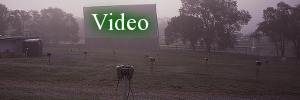















The Last Clear Chance |
|---|

|
| Topic Navigation |
|---|
|
Page Sections
History Video |
History
The following section is a description of the film from The Internet Archive.
This engaging Kodachrome drama (formatted for television broadcast) from the Union Pacific ostensibly deals with safety at railroad grade crossings, but it's also about much more: youth's feeling of invulnerability; the highway patrolman as an authority figure; the look of the rural and urban West in the late 1950s; the urge to speed through a sparsely populated agricultural landscape; and the train's role as farmer's servant and potential killer.
This film was made just five years after The Days of Our Years but belongs to a different world. This is not the close environment of urban railroad workers, but the wide-open spaces of the agricultural West. It was shot in Idaho, and the highway patrolman who carries the film forward wears an Idaho State Patrol uniform. It's summertime and the kids are out of school. Although they are responsible for farm work, they are free to roam the countryside and do. Danger lurks in this mobile world, but not in dark, enclosed industrial spaces -- it lurks in broad daylight along a sunny railroad track. The deaths that form the film's climax happen right after lunch on what looks like a Saturday afternoon, and death takes the young rather than the old.
It's hard not to think that the Union Pacific is here again trying to pass the buck on safety. It costs lots of money to protect railroad crossings with gates and even more to construct separations between railroad rights-of-way and highways. Construction projects of this type have always involved contention between railroads and local governments, and the differing interests of railroads and government fill our history books. Suffice it to say that there's a great deal of background that isn't practical to include in the movie. Interestingly enough, the victims drive through a crossing with gates, lights and bells, so no one can pin the responsibility for this accident on corporate greed.
The most quotable line: as two railroad crewmen stand by the wrecked automobile, one says: ""Why don't they look, Frank?"" Frank responds: ""I don't know. Why don't they look?"" This short dialogue fragment, and in fact the whole movie, has become a big hit on the TV show Mystery Science Theatre 3000.
Charged with a didactic agenda, The Last Clear Chance somehow always manages to look interesting even when it gets intensely instructional. It had the benefits of an excellent cinematographer, Bert Spielvogel, who also shot two other visually distinguished films, Design for Dreaming and In the Suburbs and The Relaxed Wife.
Produced by Wondsel, Carlisle and Dunphy (New York City) for Union Pacific Railroad, 1959, 26 minutes, Kodachrome, 16mm. Director: Robert Carlisle. Script: Leland Baxter. Cinematography: Bert Spielvogel. Editor: Mort Fallick. Produced under the supervision of Francis B. Lewis, Director of Safety and Courtesy, U.P.R.R. With Bill Boyett (Patrolman Jackson); Mr. Harold Agee (Frank Dixon, Sr.); Mrs. Harold Agee (Mrs. Frank Dixon); Bill Agee (Frank Dixon, Jr.); Tim Bosworth (Alan Dixon); Christine Lynch (Betty Hutchins).
| This film is available courtesy of the Prelinger Archives (public domain).
Download The Last Clear Chance from The Internet Archive - 590MB - 25:28 |
